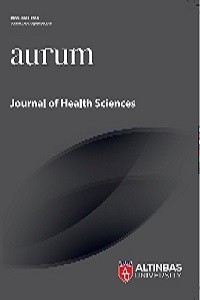The Role of Cardiopulmonary Rehabilitation in Patients with Infected COVID-19
The Role of Cardiopulmonary Rehabilitation in Patients with Infected COVID-19
___
- Australian and New Zealand Intensive Care Society Anzics Covid-19 Guidelines, ANZICS, Melbourne 16 March 2020.
- Brugliera, L., Spina, A., Castellazzi, P., Cimino P., Tettamanti, A., Houdayer, E., Pietro Arcuri, P., Alemanno, F., Mortini, P., Sandro Iannaccone, S. (2020). Letter to the editor: rehabilitation of Covid-19 patients. J Rehabil Med, 52
- Beeching, N. F., Fletcher, T. E., Fowler, R. (2020). Coronovirus disease 2019 (Covid 19) symptoms, diagnosis and treatment. BMJ Practice, London
- Gómez, V., Carlos, J., Carmen, P. G., Segura, R., Nadia, A. (2020). When Chronic Diseases Meet Infectious Diseases: A Proposal Toward Healthy Aging: Lessons from Covid-19 Outbreak Preprints; Basel, May 3, 2020. Eduardo. Neuroimmunomodulation, Basel 1-3.
- İnce, D., Yağlı, N., Sağlam, M., Kütükçü, E. (2020). Acute and Subacute Physiotherapy and Rehabilitation in Covid-19 Infection. Turkish Journal of Physiotherapy and Rehabilitation, 31(1), 81-93
- Kim, C., Jidong S. J., Lee, J. H., Won-Seok, K., Lee, G. J., Jee, S., Jung, Y., Rah, U. W., Kim, B.O., Choi, K. H., Kwon, B. S., Yoo, S. D, Bang, H. J., Shin, H. I., Kim, Y. W., Heeyoune Jung, H., Kim, E. J., et al. (2019). Clinical practice guideline for cardiac rehabilitation in Korea. Ann Rehabil Med., 43(3), 355–443
- Lazzaeri, M., Lanza, A., Bellini, R., Bellofiore, A., Cecchetto, S., Colombo, A. (2020). Respiratory physiotherapy in patients with Covid-19 infection in acute setting: a position paper of Italian Association of Respiratory Physiotherapists. Monaldi Arch Chest Dis. 90, 1285. Doi: 10.4081/monaldi.2020.1285
- Litao, Z., Xinsheng, Y., Qingkun, F., Haiyan, L., Xintian, L. (2020). D-dimer levels on admission to predict inhospital mortality in patients with Covid-19 J Thromb Haemost. 2020;18:1324–1329. Doi:10.1111/jth.14859.
- Nici, L., Donner, C., Wouters, E., Zuwallack, R., Ambrosino, N., Bourbeau, J., Carone, M., Celli, B., Engelen, M., Fahy, B., Garvey, C., Goldstein, R., Gosselink, R., Suzanne Lareau, S., MacIntyre, N., Maltais, F., Morgan, M., O’Donnell, D., Christian Prefault, C., Jane Reardon, J., Rochester, C., Schols, A., Singh, S., Troosters,T. (2006).ATS/ERS statement on pulmonary rehabilitation. Am J Respir Crit Care Med,173, 1390-413
- Polastri, M., Nava, S., Clini, E., Vitacca, M., Gosselink, R. (2020). Covid-19 and pulmonary rehabilitation: preparing for phase three 1. Eur Respir J, 55, 2001822 https://doi.org/10.1183/13993003.01822-2020
- Scherrenberg, M., Frederix, I., De Sutter, J., Dendale, P. (2020). Use of cardiac telerehabilitation during Covid-19 pandemic in Belgium, Acta Cardiologica. Doi:10.1080/00015385.2020.1786625.
- Sheehy, L. M. (2020). Considerations postacute rehabilitation for survivors of covid 19 Public health JMIR Public Health Surveill. 2020 May 8, 6(2), e19462. Doi: 10.2196/19462
- Thomas, P. A., Baldwin, C., Bissett, B., Boden, I., Gosselink, R., Granger, C. L. (2020). Physiotherapy management for Covid-19 in the acute hospital setting: recommendations to guide clinical practice. J Physiotherapy, https://doi.org/10.1016/j. jphys.2020.03.011
- Thomas, P. B., Baldwin, C., Bissett, B., Boden, I., Gosselink, R., Granger, C. L., Hodgson, C., Jones, A. Y. M., Ekho, M., Moses, R., Ntoumenopoulos, G., Parry, S. M., Patman, S., Lee, l. (2020). Physiotherapy management for Covid-19 in the acute hospital setting: clinical practicerecommendations. Journal of Physiotherapy, 66(2), 73-82.
- Vanessa, J. (2020). Coronavirus (Covid 19): İnfection control and prevention measures Journal of Primary Health Care, 12(1), 96-97. Doi: 10.1071/HC15950
- ISSN: 2651-2815
- Yayın Aralığı: Yılda 3 Sayı
- Başlangıç: 2018
- Yayıncı: Altınbaş Üniversitesi
Evaluation of the Content of National News Reflected on the Internet about Covid-19 Pandemic
Nazmiye EKİNCİ, Emin AKSAN, Merve ÖZZEYBEK TAŞ
Using Theory to Nursing Research
Application of Tramadol Hydrogel as a Transdermal Drug Delivery with Sonophoresis Device to Rats
Sitem ŞAHİN, Gülengül DUMAN, Ece GENÇ, Alper YAMAN, Elif Çiğdem ALTUNOK
Importance of Medical Imaging Methods in Medicine
Özlem YILDIRIM, İrfan AYDIN, Handan TANYILDIZI KÖKKÜLÜNK
The Role of Cardiopulmonary Rehabilitation in Patients with Infected COVID-19
Digital Planning and Mucosa-supported Guided Implant Surgery: A Case Report
Precautions Taken in Radiotherapy Clinics in Covid-19 Pandemic
The Relationship Mechanism Between Covid-19 and Renin-Angiotensin System
